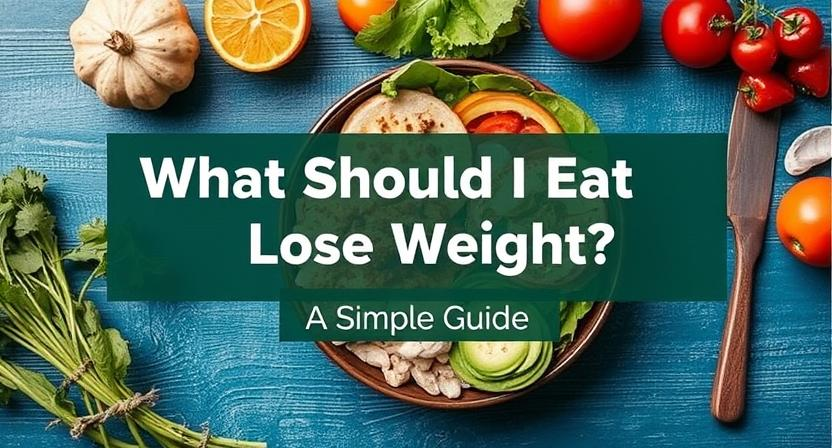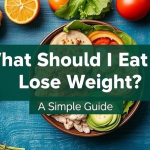Losing weight can feel overwhelming with all the diets, plans, and trends out there. From keto to intermittent fasting to plant-based lifestyles, it seems like everyone has a different answer. But if you’re asking yourself, “What should I eat to lose weight?”—the answer doesn’t have to be complicated. In this simple guide, we’ll break it down into easy steps, helping you make smart food choices without stress or confusion.
Understanding Weight Loss: The Basics
Before diving into specific foods, it’s important to understand how weight loss works. At its core, weight loss happens when you consume fewer calories than your body burns. This is called a calorie deficit.
You can create a calorie deficit by:
- Eating fewer calories
- Increasing physical activity
- Or a combination of both
But that doesn’t mean you need to starve yourself or count every calorie. Instead, focus on nutrient-dense foods that keep you full and energized while naturally helping you eat less.
The Best Foods to Eat for Weight Loss
Here are the key categories of food that can help you lose weight in a healthy, sustainable way:
1. High-Protein Foods
Protein is your best friend when it comes to fat loss. It helps preserve muscle mass, keeps you full longer, and even boosts your metabolism slightly.
Top protein-rich foods for weight loss:
- Chicken breast
- Turkey
- Eggs
- Greek yogurt
- Cottage cheese
- Lentils and beans
- Tofu and tempeh
- Fish like salmon and tuna
Aim to include a source of protein in every meal to stay full and support your body’s needs.
2. Fiber-Rich Vegetables
Vegetables are low in calories but high in fiber and water—both of which help you feel full. They’re also loaded with vitamins, minerals, and antioxidants.
Great veggies for weight loss:
- Broccoli
- Spinach
- Kale
- Zucchini
- Cauliflower
- Bell peppers
- Cabbage
- Carrots
Try to fill half your plate with vegetables during meals. Roasting, steaming, or sautéing them with a bit of olive oil makes them delicious and satisfying.
3. Whole Grains Over Refined Carbs
Whole grains provide lasting energy and help regulate blood sugar levels. Unlike refined carbs (like white bread or pastries), whole grains are digested slowly and keep you full longer.
Smart grain choices:
- Brown rice
- Quinoa
- Oats
- Whole wheat bread
- Barley
- Buckwheat
Swap out white rice or white bread for these wholesome options to improve satiety and digestion.
4. Healthy Fats
Yes, fat can help you lose fat—as long as you choose the right kind. Healthy fats support hormone balance and curb cravings.
Best sources of healthy fats:
- Avocados
- Nuts (almonds, walnuts, cashews)
- Seeds (chia, flax, sunflower)
- Olive oil
- Fatty fish like salmon
- Nut butters (in moderation)
Just remember, fat is calorie-dense, so enjoy these in small but satisfying portions.
5. Low-Sugar Fruits
Fruits are naturally sweet and full of fiber, vitamins, and antioxidants. While all fruits can fit into a weight-loss plan, some are particularly low in sugar and calories.
Good fruits for weight loss:
- Berries (strawberries, blueberries, raspberries)
- Apples
- Pears
- Oranges
- Grapefruit
- Kiwi
A bowl of mixed berries makes a perfect snack or dessert.
What to Limit or Avoi
While you don’t need to ban any food forever, limiting the following can greatly help your weight loss efforts:
1. Sugary Drinks
Soda, sweetened coffee, energy drinks, and even fruit juices are packed with sugar and empty calories. Swap these for water, sparkling water, herbal tea, or black coffee.
2. Highly Processed Foods
Chips, cookies, frozen meals, and processed meats often contain excess salt, sugar, and unhealthy fats. They’re designed to make you overeat—so limit them as much as possible.
3. Refined Carbs
White bread, pasta, pastries, and sugary cereals cause blood sugar spikes and crashes, leading to hunger and cravings.
4. Alcohol
While an occasional drink is fine, alcohol adds extra calories and may reduce your willpower when it comes to food choices.
Tips to Make Healthy Eating Easier
Losing weight doesn’t mean eating bland food or feeling hungry all the time. Here are some simple strategies to stay on track:
1. Meal Prep
Cooking your own meals gives you control over ingredients and portion sizes. Preparing meals in advance helps avoid impulsive or unhealthy eating.
2. Practice Portion Control
Use smaller plates, measure portions when needed, and be mindful of how much you’re eating—especially with calorie-dense foods like nuts or oils.
3. Stay Hydrated
Sometimes, your body confuses thirst for hunger. Drink water regularly throughout the day—especially before meals.
4. Don’t Skip Meals
Skipping meals can lead to overeating later. Instead, eat balanced meals every 4–5 hours to maintain energy and control appetite.
5. Eat Mindfully
Slow down, chew thoroughly, and pay attention to hunger and fullness cues. Avoid eating while distracted, like watching TV or scrolling on your phone.
Sample Daily Meal Plan
Here’s a simple meal plan that includes weight-loss-friendly foods:
Breakfast:
Greek yogurt with blueberries, chia seeds, and a drizzle of honey
Snack:
Apple slices with almond butter
Lunch:
Grilled chicken salad with mixed greens, cherry tomatoes, cucumber, olive oil, and vinegar
Snack:
A boiled egg and a handful of baby carrots
Dinner:
Baked salmon, quinoa, and steamed broccoli
Dessert (optional):
A few squares of dark chocolate or a small bowl of fresh fruit
Final Thoughts
So, what should you eat to lose weight? The answer is simple: focus on real, whole foods—especially protein, vegetables, healthy fats, and whole grains. Limit sugar, refined carbs, and processed foods, but don’t be too hard on yourself if you enjoy the occasional treat.
Weight loss is a journey, not a sprint. By making gradual, sustainable changes to your eating habits, you’ll not only shed pounds but also improve your health, energy, and confidence.
Remember, the goal isn’t perfection—it’s progress. Eat well, stay active, be kind to yourself, and let your results follow.






Leave a Reply